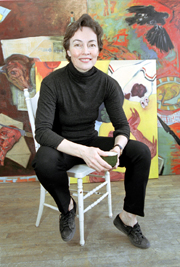
Painter and studio arts
lecturer, Michèle Delisle. Below are two of her works.
Photo by Andrew Dobrowolskyj

Grande table au cochon,
(1999)

Grande table au poisson (1999).
|
by
Wendy Fletcher
Painter and Studio Arts lecturer Michèle Delisle is the cultural
steam-engine behind Arte in Italia, an annual month-long observation drawing
course taught every spring in Bolsena, Central Italy.
This six-credit Fine Arts course gives students an opportunity to learn
drawing techniques in one of the world’s richest cultural centres,
and to become acquainted with many schools of art, from ancient Rome through
the Gothic and Byzantine periods to the Renaissance, with influences from
the Middle East.
Delisle is herself a Concordia graduate in Fine Arts (1982). A working
artist, she moved to Florence in 1985, returning to Montreal each summer
to teach. Now she is perfectly trilingual — French, English and Italian.
She has been teaching part-time in Concordia’s Studio Arts Department
since 1983.
Wanting to share her love of Italy’s artistic and historical richness,
she proposed the course in Italy, and it was launched in 1988, on a shoestring,
in Jesi, on Italy’s Adriatic coast. Each spring since then, she takes
15 students there, initiating them in the art of seeing with all five
senses and capturing the experience on the page.
“It is an apprenticeship of presenting what you’re seeing,”
Delisle said in an interview. The course is open to students from any
university – in fact, anyone who wants to explore their creative
potential.
While learning how to keep a sketchbook of their observations from nature,
art, architecture and daily life, students learn to analyze space, choose
and develop a subject; they learn to understand the structure and dynamism
of composition, and the essence of perspective.
What makes the course special is that the scenes and emotions the students
are learning to render are rooted in the reality of Etruscan Italy.
“I do my best to show students the most beautiful scenes I know of,”
exclaimed Delisle, who can barely contain her enthusiasm for the country.
The scent of jasmine and roses waft over the vistas of Bolsena, where
she has taught the course for the last 10 years.
Bolsena is a small medieval town of 6,000 between Florence and Rome. The
town’s history can be traced to the first Iron Age through the ruins
of Villanovan villages under the waters of Lake Bolsena. The birthplace
of the martyr St. Christina, Bolsena is the site of a religious festival
on June 10, when believers draw elaborate images on the streets and colour
them in with fresh-cut flowers.
The Concordia students stay in a pension on the outskirts of an ancient
volcanic crater, in the heart of a huge garden. They are close to the
town centre, where merchants sell fish, cheese, olives and vegetables
in a square dating back to the 18th century.
Mornings are spent drawing, and afternoons studying Italian language and
culture, and discussing their work. They take day trips to cultural sites,
such as Orvieto and Florence. The trip ends in Rome, where the group spends
three days exploring the principle monuments under the guidance of a local
specialist in art history and archaeology. Some students stay on after
the course for more touring.
The trip costs $3,630; this includes tuition, an introductory course in
Italian, plane tickets, room and board and excursions.
Delisle says from experience that it’s the kind of trip that changes
students’ lives. “Very strong bonds are created during this
one-month experience, and your way of seeing and understanding the complexity
of art history changes forever.”
|
|
|



